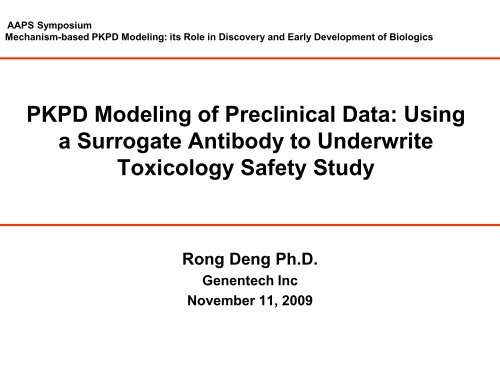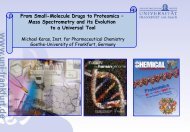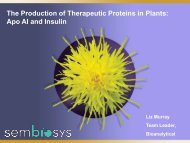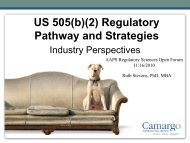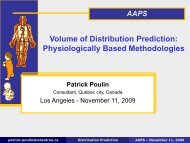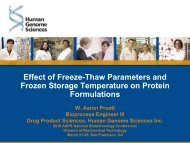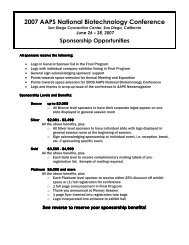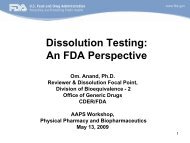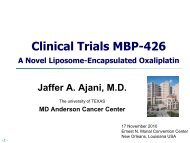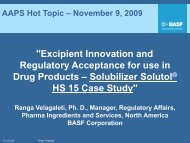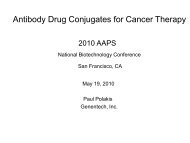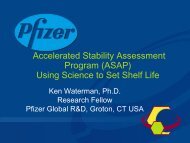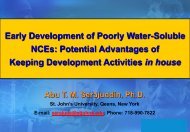PKPD Modeling of Preclinical Data: Using a Surrogate Antibody to ...
PKPD Modeling of Preclinical Data: Using a Surrogate Antibody to ...
PKPD Modeling of Preclinical Data: Using a Surrogate Antibody to ...
You also want an ePaper? Increase the reach of your titles
YUMPU automatically turns print PDFs into web optimized ePapers that Google loves.
AAPS Symposium<br />
Mechanism-based <strong>PKPD</strong> <strong>Modeling</strong>: its Role in Discovery and Early Development <strong>of</strong> Biologics<br />
<strong>PKPD</strong> <strong>Modeling</strong> <strong>of</strong> <strong>Preclinical</strong> <strong>Data</strong>: <strong>Using</strong><br />
a <strong>Surrogate</strong> <strong>Antibody</strong> <strong>to</strong> Underwrite<br />
Toxicology Safety Study<br />
Rong Deng Ph.D.<br />
Genentech Inc<br />
November 11, 2009
Outline<br />
• Efalizumab and its murine surrogate, muM17<br />
• Pharmacokinetics (PK)/Pharmacodynamics (PD)<br />
relationship <strong>of</strong> efalizumab in human and muM17 in<br />
mice<br />
• Mechanism-based PK/PD modeling and simulations<br />
for muM17 in mice <strong>to</strong> support safety studies<br />
• Conclusions
Efalizumab<br />
• Humanized IgG1 mAb<br />
• Binds <strong>to</strong> the CD11a chain <strong>of</strong><br />
leukocyte function antigen-1 (LFA-1)<br />
• Blocks interaction between LFA-1 on<br />
T-cell and intracellular adhesion<br />
molecule (ICAM) on APC, endothelia<br />
cells and keratinocytes<br />
• Efalizumab was approved in the<br />
United States and Europe for<br />
treatment <strong>of</strong> moderate <strong>to</strong> severe<br />
plaque psoriasis in 2003<br />
Werther WA, et al. J Immunol. 1996;157:4986-4995.<br />
Krueger JG. J Am Acad Derma<strong>to</strong>l. 2002;46:1-23.
Challenges for Efalizumab Development<br />
• Efalizumab is specific for chimpanzee and human<br />
CD11a but does not recognize CD11a from other nonhuman<br />
primates<br />
• Since efalizumab modulates immune responses and<br />
given its target population, reproductive <strong>to</strong>xicity<br />
studies were essential<br />
• A chimeric rat anti-mouse CD11a antibody, muM17,<br />
was developed and evaluated as a species-specific<br />
surrogate molecule for efalizumab
muM17 has Comparable in vitro<br />
Pharmacological Activity <strong>to</strong> Efalizumab<br />
Efalizumab<br />
muM17<br />
is<strong>to</strong>type<br />
binding domain<br />
Humanized full-length mAb<br />
IgG1<br />
I domain <strong>of</strong> human CD11a<br />
(AA 193-207)<br />
Chimeric rat /mouse IgG2a<br />
I domain <strong>of</strong> mouse CD11a<br />
(AA 126-129)<br />
Binding affinity <strong>to</strong> blood<br />
leukocytes<br />
3.0 1.5nM 2.7 1.2nM<br />
Mixed lymphocyte<br />
response<br />
IC50 0.06-0.09 µg/mL<br />
IC50 0.1-0.3 µg/mL
muM17 has Comparable in vivo<br />
Pharmacological Activity <strong>to</strong> Efalizumab<br />
Efalizumab<br />
muM17<br />
Pharmacological activity in<br />
vivo<br />
PD effects<br />
PK/PD relationship<br />
Safety pr<strong>of</strong>iles<br />
Tissue cross-reactivity<br />
Placental transfer<br />
Demonstrated activity in<br />
patients with psoriasis<br />
Demonstrated activity in delayed<br />
type hypersensitivity (DTH) study<br />
similar<br />
muM17 in female CD-1 mice is proposed <strong>to</strong> be a suitable surrogate molecule for<br />
testing selected pharmacological and <strong>to</strong>xicological activities <strong>of</strong> efalizumab in human
What is the clinically relevant dose <strong>of</strong><br />
the surrogate molecule muM17 for<br />
efalizumab <strong>to</strong>xicology studies
Efalizumab PK and PD Pr<strong>of</strong>iles Following 1 mg/kg/wk for 12 Weeks in<br />
Patients with Moderate <strong>to</strong> Severe Psoriasis<br />
•Within 24 h after efalizumab dosing in humans, maximum PD effects (>80%<br />
CD11a down modulation) were observed.<br />
•The maximum PD effects were maintained until efalizumab concentrations<br />
in the circulation decreased <strong>to</strong> ~1 µg/mL
MuM17 PK and PD Pr<strong>of</strong>iles Following Single SC<br />
Administration in CD-1 Mice<br />
• Dose-dependent plasma elimination <strong>of</strong><br />
muM17 and duration <strong>of</strong> CD11a down<br />
modulation.<br />
• muM17 rapid elimination occurred when<br />
concentrations fell below 10 µg/mL<br />
• Maximum down modulation <strong>of</strong> CD11a<br />
expression (
Dose Equivalency <strong>of</strong> Efalizumab in<br />
Human and muM17 in Mice<br />
Is it possible that dose equivalency <strong>of</strong> efalizumab in human and<br />
muM17 in mice could be determined based on PK pr<strong>of</strong>iles<br />
Yes<br />
AUC, Cmax, or time above<br />
threshold concentration<br />
etc<br />
PD<br />
NO<br />
•The capacities <strong>of</strong> the target<br />
recep<strong>to</strong>r (CD11a on T-<br />
lymphocytes) in mice and<br />
humans are different<br />
visual inspection SD SC data<br />
<strong>of</strong> muM17 in mice<br />
modeling and<br />
simulation approach<br />
3 mg/kg muM17 is the minimum dose <strong>to</strong> maximally<br />
down modulate CD11a expression for at least 1 week
Mechanism-based PK/PD Model <strong>of</strong> muM17<br />
1,<br />
• IV and SC single-dose PK/PD data are simultaneously fitted by<br />
NONMEM<br />
• The PK/PD model for muM17 was validated by visual comparison <strong>of</strong><br />
simulated versus observed data from an external PK/PD dataset
The Proposed Recep<strong>to</strong>r-mediated PK/PD Model Described both<br />
the PK and PD <strong>of</strong> muM17 well after Single Dose in CD-1 Mice<br />
Table 1. PK/PD parameters <strong>of</strong> muM17 and Efalizumab<br />
Estimated <strong>Using</strong> Nonlinear Mixed-Effect Model<br />
5 mg/kg<br />
3 mg/kg<br />
10 mg/kg<br />
Parameter muM17 Efalizumab a<br />
V c (mL/kg) 44.5 20.0 71.6 5.8<br />
K 12 (1/day) 56.1 70.1 0.283 0.060<br />
K 21 (1/day) 59.9 29.3 0.506 0.037<br />
K 01 (1/day) 1.53 0.135 N/A<br />
K 10 (1/day) 0.162 0.072 0.0992 0.0107<br />
V max1 (µg/kg/day/%CD11a) 27.4 3.24 1.47 0.19<br />
V max2 (1/day) 13.2 1.19 1.34 0.36<br />
K mc (µg/mL) 9.38 1.81 0.248 0.079<br />
K 03 (%CD11a/day) 79.8 10.3 43.5 15.7<br />
K 30 ( 1/day) 0.890 0.137 0.467 0.173<br />
F (%) 84.0 0.0287 NA<br />
3 mg/kg<br />
5 mg/kg<br />
Values given as mean SE<br />
NA, Not estimated<br />
a<br />
Values obtained from published data (Bauer R.J., JPB,1999,27:397)<br />
10 mg/kg
The Model Described the PK and PD <strong>of</strong> muM17 well after Multiple Doses<br />
3 mg/kg SC weekly X2<br />
The mechanistic-based PK/PD model was validated using an external sparse data set
Model-simulated Mouse versus Observed Human CD11a Expression<br />
on T-lymphocyte-time Pr<strong>of</strong>iles Following 12 weekly SC Doses<br />
•CD11a expression after a dose <strong>of</strong> 1 mg/kg/week muM17 was approximately<br />
60% <strong>of</strong> baseline during the dosing period, whereas maximum CD11a down<br />
modulation (
Conclusions<br />
• A PD marker was used <strong>to</strong> select the relevant dose for<br />
<strong>to</strong>xicology studies in mice<br />
• A mechanism-based PK/PD model helped confirm<br />
the PD-based dose equivalency <strong>of</strong> muM17 in mice<br />
and efalizumab in humans<br />
• This approach may be helpful in finding the clinically<br />
relevant dose <strong>of</strong> a surrogate molecule for <strong>to</strong>xicology<br />
studies <strong>of</strong> other protein therapeutics
Acknowledgments<br />
All my colleagues in Dev Sci at Genentech!!!
References<br />
• Wu B, Joshi A, Ren S, Ng C. The application <strong>of</strong> mechanism-based PK/PD modeling<br />
in pharmacodynamic-based dose selection <strong>of</strong> muM17, a surrogate monoclonal<br />
antibody for efalizumab. J Pharm Sci. 2006,95:1258-1268<br />
• Clarke J, Leach W, Pippig S, Joshi A, Wu BM, House R, Beyer J. Evaluation <strong>of</strong> a<br />
surrogate antibody for preclinical safety testing <strong>of</strong> an anti-CD11a monoclonal<br />
antibody. Regul Toxicol Pharmacol. 2004, 40: 219-226.<br />
• Bauer RJ, Dedrick RL, White ML, Murray MJ, Garovoy MR. Population<br />
pharmacokinetics and pharmacodynamics <strong>of</strong> the anti-CD11a antibody hu1124 in<br />
human subjects with psoriasis. J Pharmacokinet Biopharm 1999, 27: 397-420<br />
• Werther WA, Gonzalez TN, O'Connor SJ, McCabe S, Chan B, Hotaling T, Champe<br />
M, Fox JA, Jardieu PM, Berman PW, Presta LG. Humanization <strong>of</strong> an anti-lymphocyte<br />
function-associated antigen (LFA)-1 monoclonal antibody and reengineering <strong>of</strong> the<br />
humanized antibody for binding <strong>to</strong> rhesus LFA-1. J Immunol. 1996,157(11):4986-95


